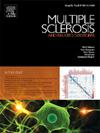进行性多发性硬化症患者根据音乐节拍器和节拍器的节拍长时间行走(有无辅助适应装置
IF 2.9
3区 医学
Q2 CLINICAL NEUROLOGY
引用次数: 0
摘要
导言:在神经系统疾病患者的步态康复治疗中,尤其是在多发性硬化症患者(PwMS)的步态康复治疗中,经常使用声学节奏,从而使步态的各个方面得到直接和持续的改善。研究表明,使用自适应音乐播放器,通过操纵节拍和脚步之间的时间差来调整节拍,从而优化同步性,已被证明能为其他神经系统疾病患者的步态带来额外的益处。这项研究将这一研究扩展到以高度残疾为特征的进行性多发性硬化症,调查自适应音乐播放器对长时间行走的影响。方法受试者根据音乐和节拍器中的节拍行走,使用或不使用辅助适应装置,使节拍与脚步一致,以保持同步,以首选的步速行走八分钟,同时测量同步性(结果矢量长度;RVL)、时空步态参数和步态动态(使用去趋势波动分析的分形缩放指数)。研究共纳入了 17 名高龄患者(中位数速度=1.13 米/秒)和 20 名重症肌无力患者(中位数 EDSS=4,中位数速度=0.85 米/秒)。在所有参与中,a)第一分钟与所有分钟相比,同步一致性更高;b)不同组之间,HCs 与 PwPMS 相比,同步一致性更高;c)不同刺激之间,节拍器与音乐相比,同步一致性更高;d)适应性条件与非适应性条件相比,同步一致性更高。与静默行走相比,自适应节拍器的步速(平均值=-4.08)低于非自适应节拍器的步速(平均值=-1.83)(t=-3.11,p=0.011)。总体而言,与非适应条件相比,适应条件下的分形缩放分量更高(F(1,103)=22.60, p<0.001),与节拍器相比,随着音乐行走时的分形缩放分量更高(F(1,103)=9.96, p<0.01)。与稳定节奏相比,在辅助适应条件下行走时步速明显降低,而且适应条件增加了分形缩放分量。本文章由计算机程序翻译,如有差异,请以英文原文为准。
Prolonged walking to beats in music and metronomes with and without assistive adaptations in persons with progressive MS
Introduction
Acoustic rhythms are frequently employed in gait rehabilitation for individuals with neurological conditions, more specifically in persons with MS (PwMS), leading to both immediate and sustained improvements in various aspects of gait. Research showed that the use of an adaptive music player, to optimize synchronization, by aligning beats by manipulating the timing difference between beats and footfalls, has been shown to provide additional benefits to gait in other neurological disorders. This work expands this to progressive MS, characterized by higher disability, investigating the effect of an adaptive music player on prolonged walking.
Methods
Participants walked to beats in music and metronomes with and without assistive adaptations, aligning the beats with the footfall, in order to maintain synchronization, at preferred walking cadence for eight minutes while synchronization (Resultant Vector Length; RVL), spatiotemporal gait parameters and gait dynamics (fractal scaling exponent using Detrended Fluctuation Analysis) were measured.
Results
17 HCs (median Speed=1.13m/s) and 20 PwPMS (median EDSS=4, median Speed=0.85m/s) were included in the study. Higher synchronization consistency was seen a) in the first minute compared to all minutes in all participation, and b) between groups, higher for HCs compared to PwPMS, c) between stimuli, higher for metronome compared to music and d) higher for adaptive compared to non-adaptive conditions. Compared to walking in silence, gait speed was lower for adaptive-metronome (mean=-4.08) compared to non-adaptive-metronome (mean=-1.83) (t=-3.11, p=0.011). Overall, the fractal scaling component was higher in the adaptive compared to the non-adaptive conditions (F(1,103)=22.60, p<0.001), as well as when walking to music compared to metronome (F(1,103)=9.96, p<0.01).
Conclusion
PwPMS were able to synchronize their steps to beats in music and metronomes during eight minutes of walking with higher synchronization consistency for adaptive conditions. Gait speed was significantly lower when walking with assistive adaptions compared to a steady rhythm and adaptive conditions increased the fractal scaling component.
求助全文
通过发布文献求助,成功后即可免费获取论文全文。
去求助
来源期刊

Multiple sclerosis and related disorders
CLINICAL NEUROLOGY-
CiteScore
5.80
自引率
20.00%
发文量
814
审稿时长
66 days
期刊介绍:
Multiple Sclerosis is an area of ever expanding research and escalating publications. Multiple Sclerosis and Related Disorders is a wide ranging international journal supported by key researchers from all neuroscience domains that focus on MS and associated disease of the central nervous system. The primary aim of this new journal is the rapid publication of high quality original research in the field. Important secondary aims will be timely updates and editorials on important scientific and clinical care advances, controversies in the field, and invited opinion articles from current thought leaders on topical issues. One section of the journal will focus on teaching, written to enhance the practice of community and academic neurologists involved in the care of MS patients. Summaries of key articles written for a lay audience will be provided as an on-line resource.
A team of four chief editors is supported by leading section editors who will commission and appraise original and review articles concerning: clinical neurology, neuroimaging, neuropathology, neuroepidemiology, therapeutics, genetics / transcriptomics, experimental models, neuroimmunology, biomarkers, neuropsychology, neurorehabilitation, measurement scales, teaching, neuroethics and lay communication.
 求助内容:
求助内容: 应助结果提醒方式:
应助结果提醒方式:


